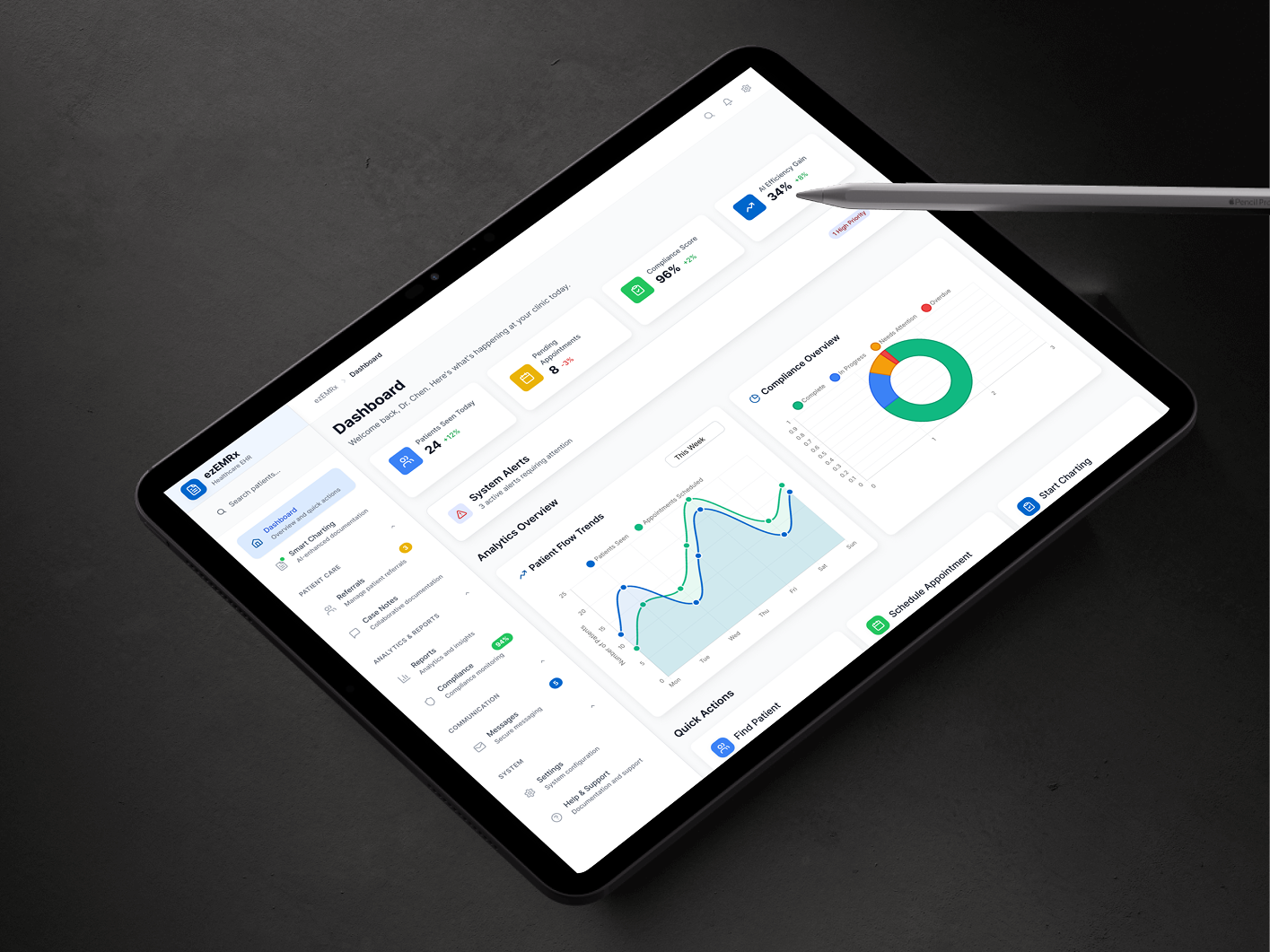📌 TL;DR
Role
Founding Product Designer
Type
B2B SaaS – Healthcare / EHR
Timeline
Jan–Aug 2024
Team
Cross-functional squad (PM, engineers, clinical SMEs)
Tools
Figma, Notion, Framer, Jira, ChatGPT
Company
Custom Data Processing Inc.
Key Impact Metrics
↓ average scheduling time
↑ triage efficiency
↑ compliance pass rate
↓ admin overhead
📌 Project Overview & Objectives
Symplify was designed to modernize fragmented hospital and public health workflows into a single, AI-driven platform. The initiative was a 0 → 1 system redesign, targeting inefficiencies in scheduling, communication, and compliance.
Business Objectives
- Reduce time spent on administrative workflows
- Improve compliance and reduce missed tasks
- Create trustable, explainable AI workflows
- Deliver a modular system extensible to state-level health programs
🎯 Challenge
Hospitals and public health programs relied on fragmented, outdated systems — leading to missed appointments, compliance gaps, and staff burnout.
- • HIPAA compliance required masking and audit logs
- • Legacy EHRs couldn't be replaced, only extended
- • Staffing shortages → adoption needed to reduce workload, not add to it
💡 Solution
Designed Symplify, an AI-enhanced, modular platform with:
- Smart Inbox Triage → Faster, explainable message prioritization
- Smart Scheduling → AI-assisted appointment management
- Smart Notifications → Reduced alert fatigue with clear priority tiers
- Unified Email Integration → Centralized communication
🔑 Why It Matters
Symplify redefined hospital workflow UX:
- Trust-first AI patterns (transparent, human-in-the-loop)
- Scalable modular design system for clinics and state agencies
- Accessibility-first (WCAG 2.1 AA compliant)
Visual Asset Suggestion: Quick KPI infographic (Before vs After), paired with one hero dashboard screenshot for immediate impact.
🧠 Problem Statement & Research
Core Problem
Hospitals and WIC programs were relying on outdated, siloed tools:
- Messages scattered across multiple channels
- Appointment scheduling required manual reconciliation
- Compliance notifications buried in dropdowns
The result: missed appointments, delayed responses, and staff burnout.
Research Process
I led a structured discovery process designed to capture quantitative task data and qualitative user sentiment:
Contextual Inquiry
Shadowed 12 clinic admins and 6 nurses across 3 facilities
Task Analysis
Logged over 3,000 daily tasks, identifying friction points
User Interviews
Structured interviews focusing on trust in technology and AI perceptions
Usability Testing
3 iterative rounds validating navigation clarity and AI interpretability
Stakeholder Workshops
Sessions with state agency leaders for regulatory alignment
Key Insights
60% of staff time lost
to context switching across multiple systems
40% of "urgent" messages were noise
undermining trust in alerts
Staff wanted AI augmentation, not automation
requiring transparency and control
High administrative burden
caused compliance gaps and delayed patient care
📊 Business & Market Analysis
The healthcare IT market is dominated by legacy EHR systems (Epic, Cerner, Allscripts) designed for hospitals, not public health programs or smaller clinics. These systems are:
- Costly to implement and maintain
- Not optimized for staff-facing daily workflows
- Slow to adopt modern UX and AI-driven enhancements
Opportunity for Symplify
- Deliver a modular, cost-effective alternative for public health agencies
- Differentiate with AI-enhanced task efficiency and explainability
- Position as a scalable platform bridging state agencies and local clinics
Competitor Analysis
| Feature / Platform | Epic | Cerner | Allscripts | ezEMRx | Symplify |
|---|---|---|---|---|---|
| Cost & Scalability | $$$$ | $$$$ | $$$ | $$ | $ (modular) |
| Usability (Staff-Facing) | Low | Medium | Medium | Low | High |
| AI Augmentation | Minimal | Minimal | None | None | Smart Inbox, Notifications, Scheduling |
| Accessibility (WCAG) | Inconsistent | Inconsistent | Limited | Limited | WCAG 2.1 AA Compliant |
| Suitability for Public Health | Low | Low | Medium | Medium | High |
💡 Strategic Differentiators
🎨 Design Process & Methodology
Methods
| Method | Sample | Duration | Focus | Bias Controls |
|---|---|---|---|---|
| Interviews | 14 staff (5 MD, 6 RN, 3 Admin) | 2 wks | Pain points in triage, scheduling, forecasting | Balanced roles, avoided leading questions |
| Contextual inquiry | 11 live clinic sessions | 3 days | Task handoffs, interruptions, downtime | Observed at different times of day |
| Diary study | 9 staff (mixed roles) | 2 wks | Daily frustrations + time sinks | Compared with baseline logs |
| Workflow audits | 1,200 inbox items, 150 appts | 4 wks | Handling time, delay %, no-show rate | Controlled for seasonality |
Insights → Design Moves
| Insight | Design Move | Expected Effect |
|---|---|---|
| Inbox triage consumed ~5–8 hrs/wk per clinician | Smart AI Chat Inbox Triage | ↓ triage time ~40% |
| Nurses missed 18% of urgent handoffs | AI-driven notifications + unified inbox flags | ↑ on-time follow-ups |
| Admins used Excel for forecasting; lagging visibility | Smart Unified Email + Notifications | ↑ operational visibility |
| Doctors manually slotted patients → 10% no-shows | Smart Appointment Scheduling | ↓ no-shows, ↑ throughput |
| Staff wary of "black box AI" | AI Transparency features | ↑ adoption & trust |
Quotes
"Half my inbox is reminders I don't need today — I just want the urgent ones."— MD, Clinic A
"When shifts overlap, I'm never sure if a message was handled already."— RN, Clinic B
"Forecasting is basically a guess until month close --then it's too late."— Admin, Clinic C
User Flows & Journey Mapping
To connect our research insights directly to staff workflows, we mapped out thedaily journeys of three key roles — Doctor, Nurse, and Admin. This role-based swimlane visualization reveals where delays, errors, and inefficiencies occurred before Symplify, and how AI interventions resolved them.
Role-Based User Journey Map
Doctor
Daily Workflow
- ❗Review inbox (manual triage ~2m/item, high backlog)
- ❗Confirm appointments (double entry in EHR + spreadsheets)
- Update patient chart
- Billing close
AI Intervention
- ✓AI Inbox Triagesorts by clinical risk + SLA urgency
- ✓Smart Schedulingpredicts no-shows, optimizes appointment slots
Nurse
Daily Workflow
- Track vitals
- Update patient chart
- ❗Triage patient messages (handoffs missed at shift change)
- ❗Handoff to doctor (no clear ownership)
AI Intervention
- ✓Unified Inbox + Handoff Flagsensure urgent items are surfaced, ownership is visible
Admin
Daily Workflow
- ❗Manage staffing (scheduling conflicts, no predictive insight)
- Monitor hospital operations
- ❗Generate revenue reports (monthly Excel exports, lagging visibility)
AI Intervention
- ✓Revenue Forecasting Dashboardreal-time visibility into operational metrics


